warning VOLVO V60 2014 Owners Manual
[x] Cancel search | Manufacturer: VOLVO, Model Year: 2014, Model line: V60, Model: VOLVO V60 2014Pages: 442, PDF Size: 13.85 MB
Page 306 of 442
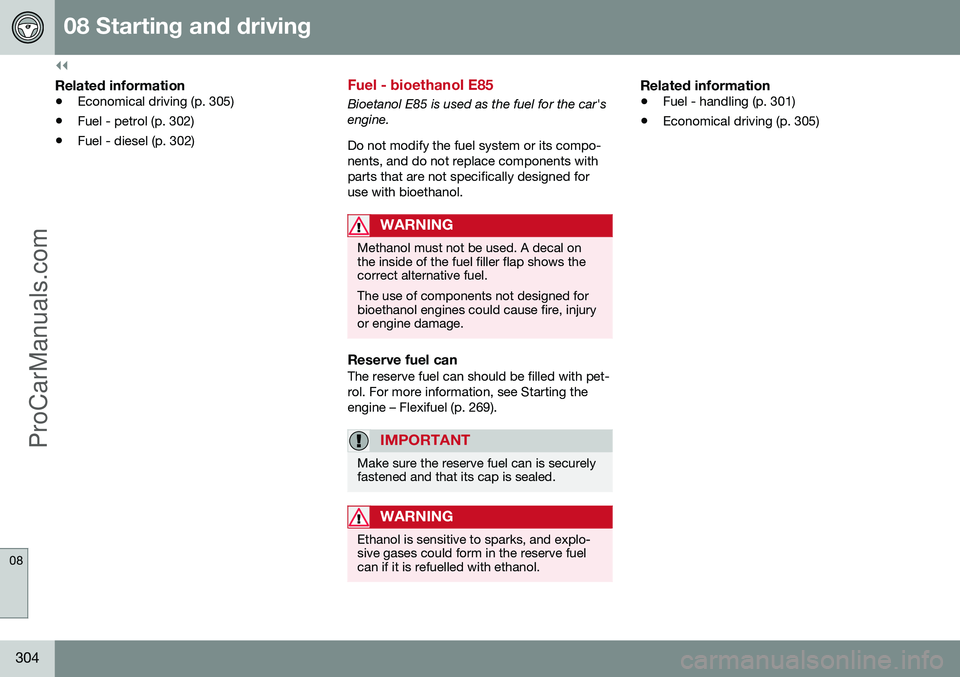
||
08 Starting and driving
08
304
Related information
•Economical driving (p. 305)
• Fuel - petrol (p. 302)
• Fuel - diesel (p. 302)
Fuel - bioethanol E85
Bioetanol E85 is used as the fuel for the car's engine. Do not modify the fuel system or its compo- nents, and do not replace components withparts that are not specifically designed foruse with bioethanol.
WARNING
Methanol must not be used. A decal on the inside of the fuel filler flap shows thecorrect alternative fuel. The use of components not designed for bioethanol engines could cause fire, injuryor engine damage.
Reserve fuel canThe reserve fuel can should be filled with pet- rol. For more information, see Starting theengine – Flexifuel (p. 269).
IMPORTANT
Make sure the reserve fuel can is securely fastened and that its cap is sealed.
WARNING
Ethanol is sensitive to sparks, and explo- sive gases could form in the reserve fuelcan if it is refuelled with ethanol.
Related information
• Fuel - handling (p. 301)
• Economical driving (p. 305)
ProCarManuals.co’
Page 307 of 442
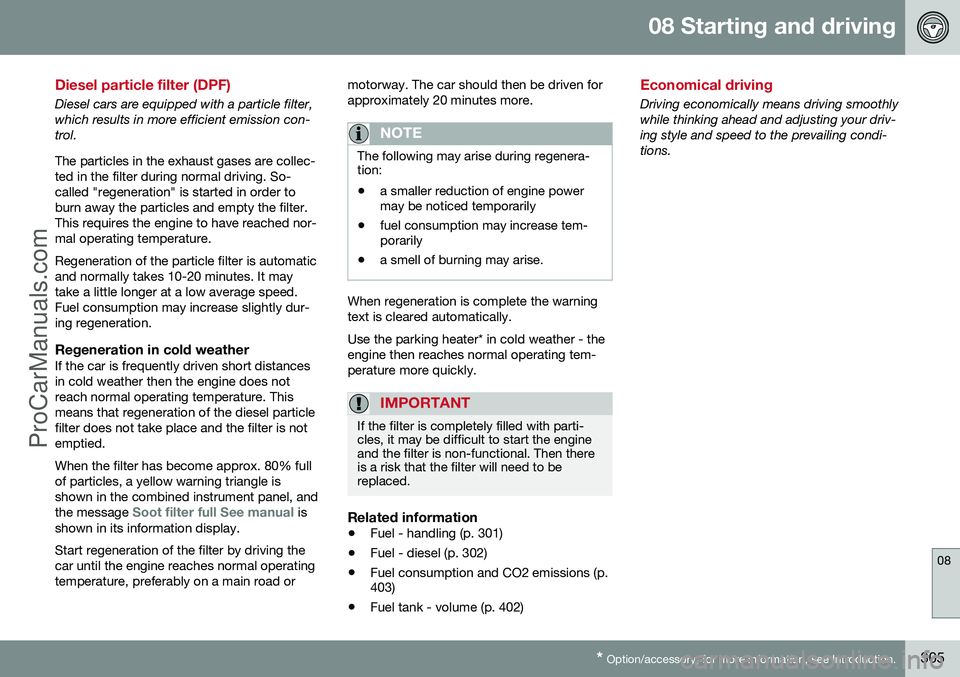
08 Starting and driving
08
* Option/accessory, for more information, see Introduction.305
Diesel particle filter (DPF)
Diesel cars are equipped with a particle filter, which results in more efficient emission con-trol. The particles in the exhaust gases are collec- ted in the filter during normal driving. So-called "regeneration" is started in order toburn away the particles and empty the filter.This requires the engine to have reached nor-mal operating temperature. Regeneration of the particle filter is automatic and normally takes 10-20 minutes. It maytake a little longer at a low average speed.Fuel consumption may increase slightly dur-ing regeneration.
Regeneration in cold weatherIf the car is frequently driven short distancesin cold weather then the engine does notreach normal operating temperature. Thismeans that regeneration of the diesel particlefilter does not take place and the filter is notemptied. When the filter has become approx. 80% full of particles, a yellow warning triangle isshown in the combined instrument panel, and the message
Soot filter full See manual is
shown in its information display. Start regeneration of the filter by driving the car until the engine reaches normal operatingtemperature, preferably on a main road or motorway. The car should then be driven forapproximately 20 minutes more.
NOTE
The following may arise during regenera- tion:
• a smaller reduction of engine power may be noticed temporarily
• fuel consumption may increase tem-porarily
• a smell of burning may arise.
When regeneration is complete the warning text is cleared automatically. Use the parking heater* in cold weather - the engine then reaches normal operating tem-perature more quickly.
IMPORTANT
If the filter is completely filled with parti- cles, it may be difficult to start the engineand the filter is non-functional. Then thereis a risk that the filter will need to bereplaced.
Related information
•
Fuel - handling (p. 301)
• Fuel - diesel (p. 302)
• Fuel consumption and CO2 emissions (p. 403)
• Fuel tank - volume (p. 402)
Economical driving
Driving economically means driving smoothly while thinking ahead and adjusting your driv-ing style and speed to the prevailing condi-tions.
ProCarManuals.com
Page 308 of 442

||
08 Starting and driving
08
306* Option/accessory, for more information, see Introduction.
• For lowest fuel consumption, activate ECO (p. 288)* 16
.
• Use the ECO Guide which indicates how fuel-efficiently the car is being driven, seeEco guide & Power guide* (p. 63).
• Drive in the highest gear possible, adap-ted to the current traffic situation androad - lower engine speeds result in lowerfuel consumption. Use the gear indicator(p. 272).
• Avoid sudden unnecessary accelerationand heavy braking.
• High speed results in increased fuel con-sumption - the wind resistance increaseswith speed.
• Do not run the engine to operating tem-perature at idling speed, but rather drivewith a light load as soon as possible - acold engine consumes more fuel than awarm one.
• Drive with the correct air pressure in thetyres and check this regularly - selectECO tyre pressure for best results, seeTyres - approved tyre pressures (p. 407).
• Choice of tyres can affect fuel consump-tion - seek advice on suitable tyres from adealer.
• Remove unnecessary items from the car -the greater the load the higher the con-sumption. •
Use engine braking to slow down, when itcan take place without risk to other roadusers.
• A roof load and ski box increase air resis-tance, leading to higher consumption -remove the load carriers when not in use.
• Avoid driving with open windows.
For information about Volvo Car Corpora- tion's environmental philosophy, see VolvoCars' environmental philosophy (p. 19). For more information about fuel consumption, see Fuel consumption and CO2 emissions (p.403).
WARNING
Never switch off the engine while moving, such as downhill, this deactivates impor-tant systems such as the power steeringand brake servo.
Related information
• Fuel - handling (p. 301)
• Fuel consumption and CO2 emissions (p. 403)
• Fuel tank - volume (p. 402)
Driving with a trailer
When driving with a trailer there are a number of important points to think about regardinge.g. the towing bracket, the trailer and howthe load is positioned in the trailer. Payload depends on the car's kerb weight. The total of the weight of the passengers andall accessories, e.g. towbar, reduces the car'spayload by a corresponding weight. For moredetailed information on weights, see Weights(p. 390). If the towing bracket is mounted by Volvo, then the car is delivered with the necessaryequipment for driving with a trailer. • The car's towing bracket must be of an approved type.
• If the towbar is retrofitted, check withyour Volvo dealer that the car is fullyequipped for driving with a trailer.
• Distribute the load on the trailer so thatthe weight on the towing bracket com-plies with the specified maximum towballload.
• Increase the tyre pressure to the recom-mended pressure for a full load. For tyrepressure label location, see Tyres - airpressure (p. 328).
• The engine is loaded more heavily thanusual when driving with a trailer.
16
Only applies to cars with automatic gearbox.
ProCarManuals.co’
Page 309 of 442

08 Starting and driving
08
* Option/accessory, for more information, see Introduction.307
•
Do not tow a heavy trailer when the car is brand new. Wait until it has been drivenat least 1000 km.
• The brakes are loaded much more thanusual on long and steep downhill slopes.Downshift to a lower gear and adjust yourspeed.
• For safety reasons, the maximum permit-ted speed for the car when coupled witha trailer should not be exceeded. Followthe regulations in force for the permittedspeeds and weights.
• Maintain a low speed when driving with atrailer up long, steep ascents.
• Avoid driving with a trailer on inclines ofmore than 12%.
Trailer cableAn adapter is required if the car's towing bracket has 13 pin electrics and the trailerhas 7 pin electrics. Use an adapter cableapproved by Volvo. Make sure the cable doesnot drag on the ground.
Direction indicators and brake lights on
the trailer
If any of the trailer's lamps for direction indi-cators are broken, then the combined instru-ment panel's symbol for direction indicatorsflashes faster than normal and the information display shows the text
Bulb fail - Ind. signal
trailer. If any of the trailer's lamps for the brake light are broken then the
Bulb fail - Stop lamp
trailer text is shown.
Level control*The rear shock absorbers maintain a constant height irrespective of the car's load (up to themaximum permissible weight). When the caris stationary the rear of the car lowers slightly,which is normal.
Trailer weightsFor information on Volvo's permitted trailerweights, see Towing capacity and towballload (p. 391).
NOTE
The stated maximum permitted trailer weights are those permitted by Volvo.National vehicle regulations can furtherlimit trailer weights and speeds. Towbarscan be certified for higher towing weightsthan the car can actually tow.
WARNING
Follow the stated recommendations for trailer weights. Otherwise, the car andtrailer may be difficult to control in theevent of sudden movement and braking.
Related information
• Driving with a trailer - manual gearbox (p. 308)
• Driving with a trailer - automatic gearbox(p. 308)
• Towing bracket/Towbar (p. 309)
• Lamp replacement (p. 352)
ProCarManuals.co’
Page 310 of 442
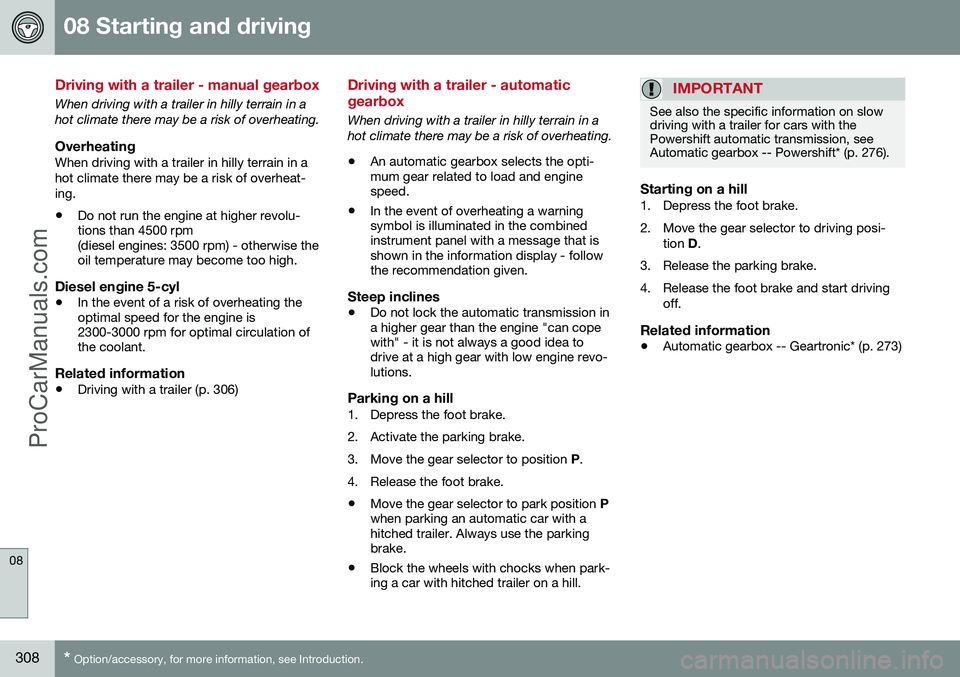
08 Starting and driving
08
308* Option/accessory, for more information, see Introduction.
Driving with a trailer - manual gearbox
When driving with a trailer in hilly terrain in a hot climate there may be a risk of overheating.
OverheatingWhen driving with a trailer in hilly terrain in ahot climate there may be a risk of overheat-ing. • Do not run the engine at higher revolu- tions than 4500 rpm(diesel engines: 3500 rpm) - otherwise theoil temperature may become too high.
Diesel engine 5-cyl
•In the event of a risk of overheating theoptimal speed for the engine is2300-3000 rpm for optimal circulation ofthe coolant.
Related information
•Driving with a trailer (p. 306)
Driving with a trailer - automatic gearbox
When driving with a trailer in hilly terrain in a hot climate there may be a risk of overheating.
• An automatic gearbox selects the opti- mum gear related to load and enginespeed.
• In the event of overheating a warningsymbol is illuminated in the combinedinstrument panel with a message that isshown in the information display - followthe recommendation given.
Steep inclines
•Do not lock the automatic transmission ina higher gear than the engine "can copewith" - it is not always a good idea todrive at a high gear with low engine revo-lutions.
Parking on a hill1. Depress the foot brake.
2. Activate the parking brake.
3. Move the gear selector to position
P.
4. Release the foot brake.
• Move the gear selector to park position
P
when parking an automatic car with a hitched trailer. Always use the parkingbrake.
• Block the wheels with chocks when park-ing a car with hitched trailer on a hill.
IMPORTANT
See also the specific information on slow driving with a trailer for cars with thePowershift automatic transmission, seeAutomatic gearbox -- Powershift* (p. 276).
Starting on a hill1. Depress the foot brake.
2. Move the gear selector to driving posi-
tion D.
3. Release the parking brake.
4. Release the foot brake and start driving off.
Related information
• Automatic gearbox -- Geartronic* (p. 273)
ProCarManuals.co’
Page 311 of 442
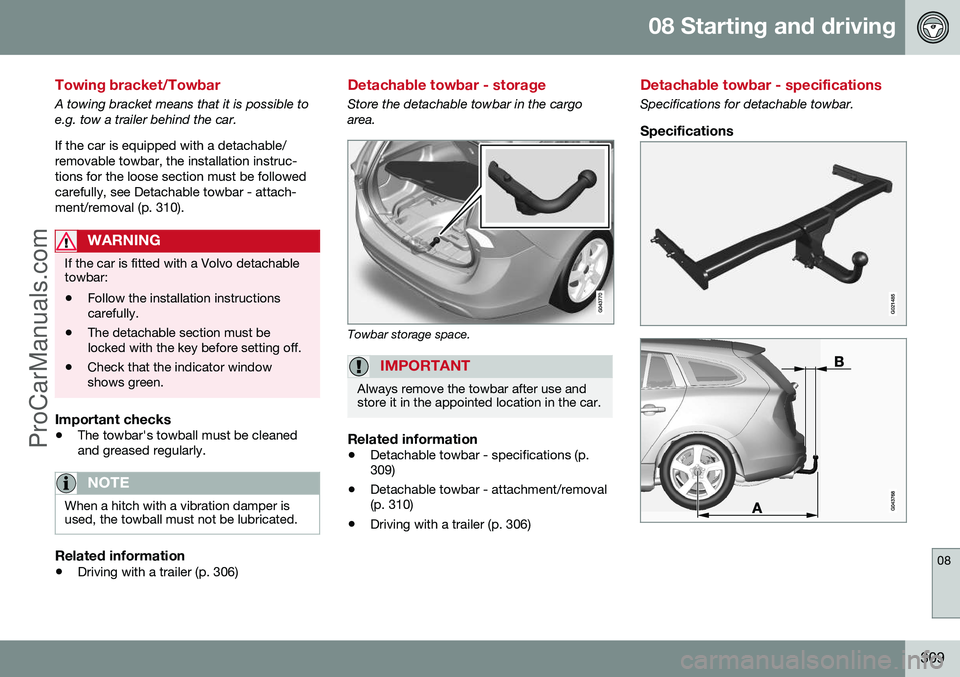
08 Starting and driving
08
309
Towing bracket/Towbar
A towing bracket means that it is possible to e.g. tow a trailer behind the car. If the car is equipped with a detachable/ removable towbar, the installation instruc-tions for the loose section must be followedcarefully, see Detachable towbar - attach-ment/removal (p. 310).
WARNING
If the car is fitted with a Volvo detachable towbar:
• Follow the installation instructions carefully.
• The detachable section must belocked with the key before setting off.
• Check that the indicator windowshows green.
Important checks
•
The towbar's towball must be cleaned and greased regularly.
NOTE
When a hitch with a vibration damper is used, the towball must not be lubricated.
Related information
•
Driving with a trailer (p. 306)
Detachable towbar - storage
Store the detachable towbar in the cargo area.
Towbar storage space.
IMPORTANT
Always remove the towbar after use and store it in the appointed location in the car.
Related information
•Detachable towbar - specifications (p. 309)
• Detachable towbar - attachment/removal(p. 310)
• Driving with a trailer (p. 306)
Detachable towbar - specifications
Specifications for detachable towbar.
Specifications
G021485
ProCarManuals.com
Page 313 of 442
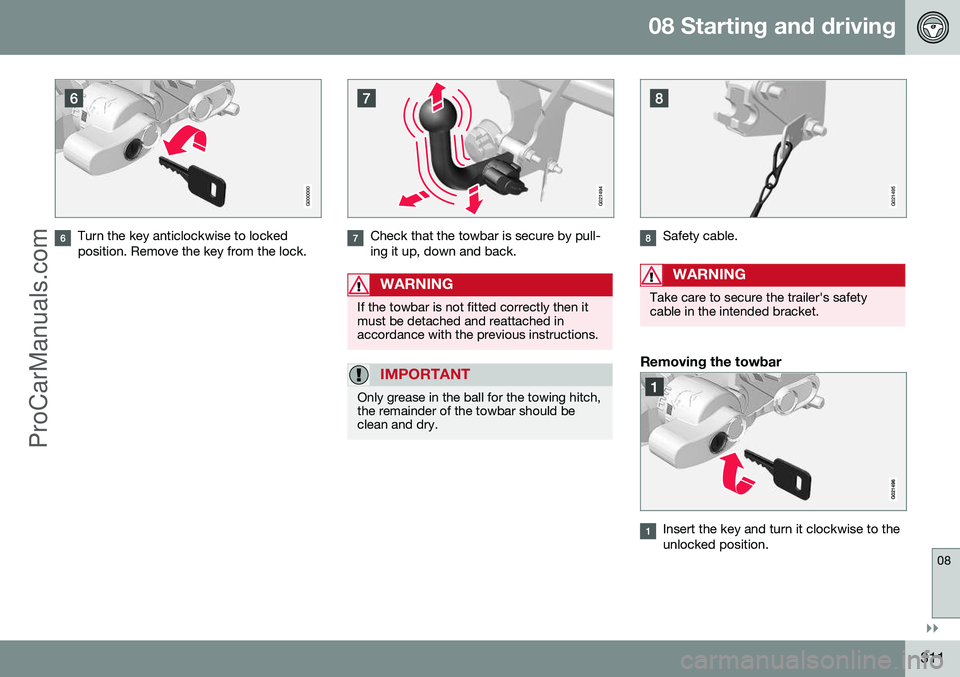
08 Starting and driving
08
}}
311
G000000
Turn the key anticlockwise to locked position. Remove the key from the lock.
G021494
Check that the towbar is secure by pull- ing it up, down and back.
WARNING
If the towbar is not fitted correctly then it must be detached and reattached inaccordance with the previous instructions.
IMPORTANT
Only grease in the ball for the towing hitch, the remainder of the towbar should beclean and dry.
G021495
Safety cable.
WARNING
Take care to secure the trailer's safety cable in the intended bracket.
Removing the towbar
Insert the key and turn it clockwise to the unlocked position.
ProCarManuals.co’
Page 314 of 442

||
08 Starting and driving
08
312
Push in the locking wheel and turn it
anticlockwise
until you hear a click.
Turn the locking wheel down fully, until it comes to a stop. Hold it in this positionwhile pulling the towbar rearward andupward.
WARNING
Secure the towbar safely if it is stored in the car, see Detachable towbar - storage(p. 309).
G018929
Push the protective cover until it snaps tight.
Related information
• Detachable towbar - storage (p. 309)
• Detachable towbar - specifications (p. 309)
• Driving with a trailer (p. 306)
Trailer stabiliser - TSA 17
The trailer stability assist (TSA - Trailer Stability Assist) function is designed to stabi-lise the car and trailer combination if it beginsto snake. The trailer stability assist is included in the stability and traction control system (p. 175)(DSTC - Dynamic Stability and TractionControl).
FunctionThe snaking phenomenon can occur with anycar/trailer combination. Snaking normallyoccurs at high speeds. But, there is a risk of itoccurring at lower speeds (70-90 km/h) if thetrailer is overloaded or the load is improperlydistributed, e.g. too far back. In order for snaking to occur, there must be a triggering factor, e.g.:
• Car with trailer subjected to a sudden and powerful side wind.
• Car with trailer drives on an uneven roadsurface or in a pothole.
• Sweeping steering wheel movements.
OperationIf snaking has started, it could be difficult or even impossible to suppress. This makes thecar/trailer combination difficult to control andthere is a risk that you could, for example,
17
Included in the installation of Volvo genuine towbar.
ProCarManuals.co’
Page 316 of 442
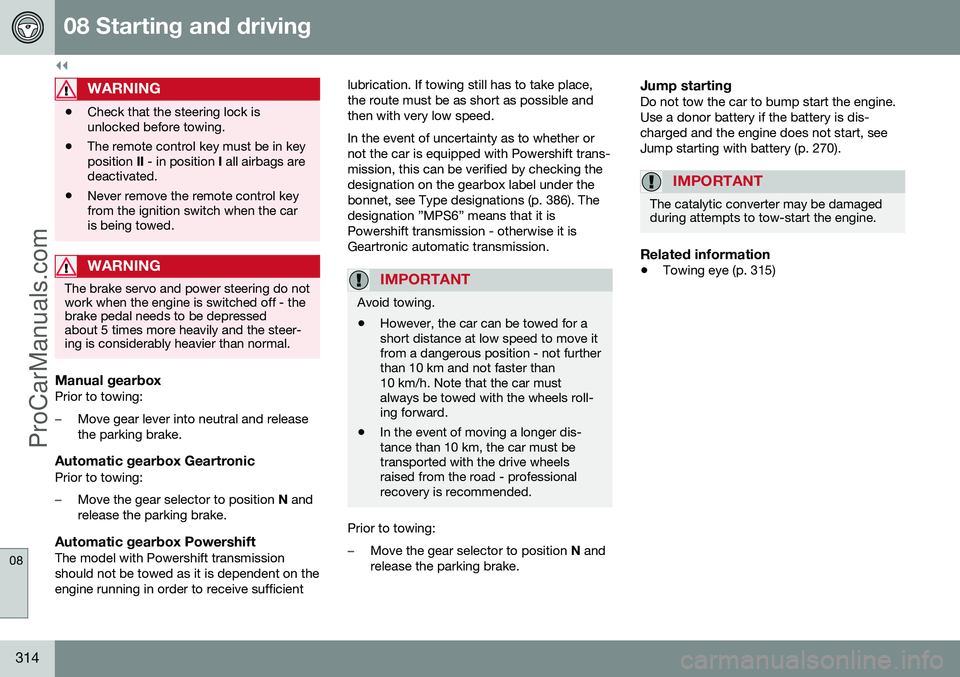
||
08 Starting and driving
08
314
WARNING
•Check that the steering lock is unlocked before towing.
• The remote control key must be in keyposition
II - in position I all airbags are
deactivated.
• Never remove the remote control keyfrom the ignition switch when the caris being towed.
WARNING
The brake servo and power steering do not work when the engine is switched off - thebrake pedal needs to be depressedabout 5 times more heavily and the steer-ing is considerably heavier than normal.
Manual gearboxPrior to towing:
–Move gear lever into neutral and release the parking brake.
Automatic gearbox GeartronicPrior to towing:
–Move the gear selector to position
N and
release the parking brake.
Automatic gearbox PowershiftThe model with Powershift transmission should not be towed as it is dependent on theengine running in order to receive sufficient lubrication. If towing still has to take place,the route must be as short as possible andthen with very low speed. In the event of uncertainty as to whether or not the car is equipped with Powershift trans-mission, this can be verified by checking thedesignation on the gearbox label under thebonnet, see Type designations (p. 386). Thedesignation ”MPS6” means that it isPowershift transmission - otherwise it isGeartronic automatic transmission.
IMPORTANT
Avoid towing.
• However, the car can be towed for a short distance at low speed to move itfrom a dangerous position - not furtherthan 10 km and not faster than10 km/h. Note that the car mustalways be towed with the wheels roll-ing forward.
• In the event of moving a longer dis-tance than 10 km, the car must betransported with the drive wheelsraised from the road - professionalrecovery is recommended.
Prior to towing:
–Move the gear selector to position
N and
release the parking brake.
Jump startingDo not tow the car to bump start the engine. Use a donor battery if the battery is dis-charged and the engine does not start, seeJump starting with battery (p. 270).
IMPORTANT
The catalytic converter may be damaged during attempts to tow-start the engine.
Related information
• Towing eye (p. 315)
ProCarManuals.co’
Page 317 of 442
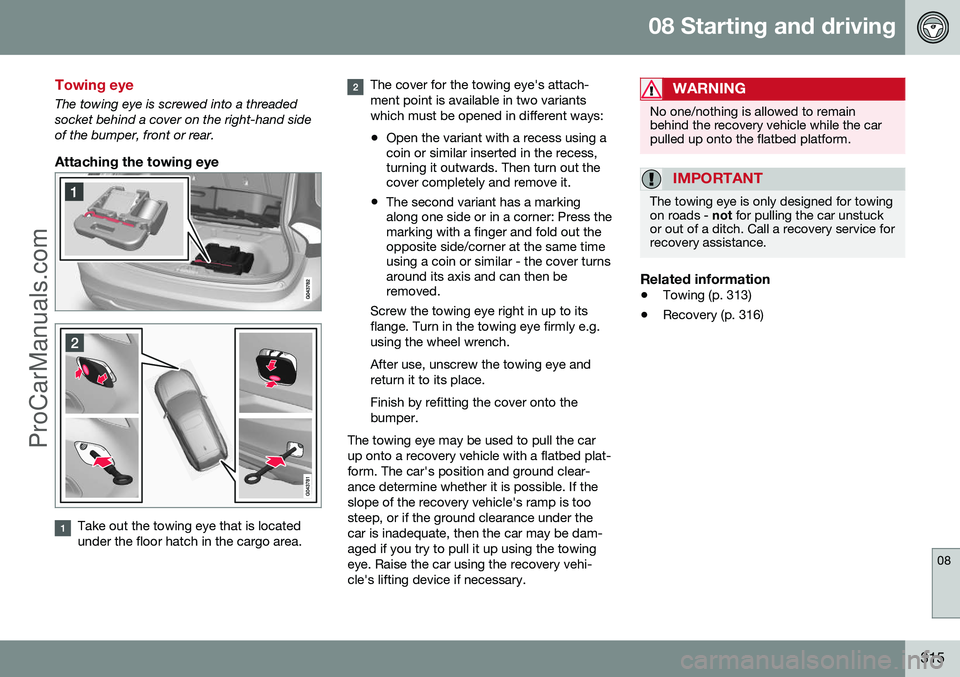
08 Starting and driving
08
315
Towing eye
The towing eye is screwed into a threaded socket behind a cover on the right-hand sideof the bumper, front or rear.
Attaching the towing eye
Take out the towing eye that is located under the floor hatch in the cargo area.
The cover for the towing eye's attach- ment point is available in two variantswhich must be opened in different ways:
• Open the variant with a recess using a coin or similar inserted in the recess,turning it outwards. Then turn out thecover completely and remove it.
• The second variant has a markingalong one side or in a corner: Press themarking with a finger and fold out theopposite side/corner at the same timeusing a coin or similar - the cover turnsaround its axis and can then beremoved.
Screw the towing eye right in up to its flange. Turn in the towing eye firmly e.g.using the wheel wrench. After use, unscrew the towing eye and return it to its place. Finish by refitting the cover onto the bumper.
The towing eye may be used to pull the carup onto a recovery vehicle with a flatbed plat-form. The car's position and ground clear-ance determine whether it is possible. If theslope of the recovery vehicle's ramp is toosteep, or if the ground clearance under thecar is inadequate, then the car may be dam-aged if you try to pull it up using the towingeye. Raise the car using the recovery vehi-cle's lifting device if necessary.WARNING
No one/nothing is allowed to remain behind the recovery vehicle while the carpulled up onto the flatbed platform.
IMPORTANT
The towing eye is only designed for towing on roads - not for pulling the car unstuck
or out of a ditch. Call a recovery service forrecovery assistance.
Related information
• Towing (p. 313)
• Recovery (p. 316)
ProCarManuals.co’